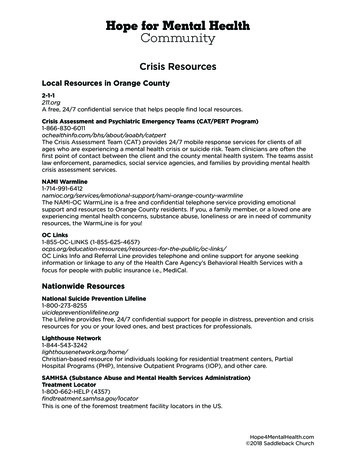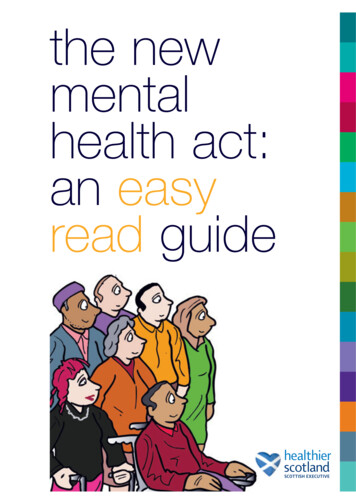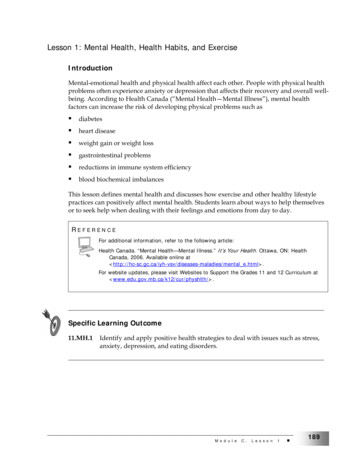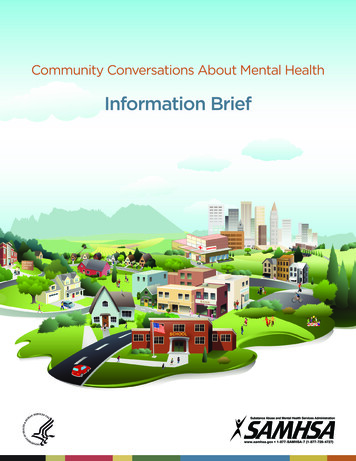
Transcription
Hope for Mental HealthCommunityCrisis ResourcesLocal Resources in Orange County2-1-1211.orgA free, 24/7 confidential service that helps people find local resources.Crisis Assessment and Psychiatric Emergency Teams (CAT/PERT oabh/catpertThe Crisis Assessment Team (CAT) provides 24/7 mobile response services for clients of allages who are experiencing a mental health crisis or suicide risk. Team clinicians are often thefirst point of contact between the client and the county mental health system. The teams assistlaw enforcement, paramedics, social service agencies, and families by providing mental healthcrisis assessment services.NAMI l-support/nami-orange-county-warmlineThe NAMI-OC WarmLine is a free and confidential telephone service providing emotionalsupport and resources to Orange County residents. If you, a family member, or a loved one areexperiencing mental health concerns, substance abuse, loneliness or are in need of communityresources, the WarmLine is for you!OC Links1-855-OC-LINKS rces-for-the-public/oc-links/OC Links Info and Referral Line provides telephone and online support for anyone seekinginformation or linkage to any of the Health Care Agency’s Behavioral Health Services with afocus for people with public insurance i.e., MediCal.Nationwide ResourcesNational Suicide Prevention The Lifeline provides free, 24/7 confidential support for people in distress, prevention and crisisresources for you or your loved ones, and best practices for professionals.Lighthouse ristian-based resource for individuals looking for residential treatment centers, PartialHospital Programs (PHP), Intensive Outpatient Programs (IOP), and other care.SAMHSA (Substance Abuse and Mental Health Services Administration)Treatment Locator1-800-662-HELP (4357)findtreatment.samhsa.gov/locatorThis is one of the foremost treatment facility locators in the US.Hope4MentalHealth.com 2018 Saddleback Church
Hope for Mental HealthCommunityCrisis Stabilization UnitEvaluation and Treatment Services(Adults)1030 West Warner AvenueSanta Ana, CA 92707Phone: (714) 834-6900Orange County Hospitalswith Psychiatric UnitsAnaheim Global Medical Center(Adults & Older Adults)(Formerly Western Medical CenterAnaheim)1025 South Anaheim Blvd.Anaheim, CA 92805Phone: (714) 533-6220 and(888) 428-7828College Hospital Costa Mesa(Adults & Adolescents)301 Victoria StreetCosta Mesa, CA 92627Phone: (949) 642-2734Huntington Beach Hospital(Older Adults)17772 Beach Blvd.Huntington Beach, CA 92627Phone: (714) 843-5020Los Alamitos Medical Center(Older Adults)3751 Katella AvenueLos Alamitos, CA 90720Phone: (562) 799-3234Mission Pacific Coast Recovery(Adults)(Located at Mission Hospital LagunaBeach)31872 Coast HighwaySouth Laguna Beach, CA 92651Phone: (949) 499-7501Newport Bay Hospital(Adults & Older Adults)1501 East 16th StreetNewport Beach, CA 92663Phone: (949) 650-9750Royale Therapeutic Residential Center1030 West Warner AvenueSanta Ana, CA 92707Phone: (714) 957-0611South Coast Global Medical Center(Older Adults)(Formerly Coastal CommunitiesHospital)2701 South Bristol StreetSanta Ana, CA 92704Phone: (714) 754-5454South Coast Post Acute(Older Adults)(Formerly Royale SNF)1030 West Warner AvenueSanta Ana, CA 92707Phone: (714) 957-0611St. Joseph Hospital(Adults)1100 West Stewart DriveOrange, CA 92868Phone: (714) 771-8134UCI Medical Center(Adults & Adolescents)101 The City Drive SouthOrange, CA 92868Phone: (714) 456-5801West Anaheim Medical Center3033 West Orange AvenueAnaheim, CA 92804Phone: (714) 827-3000 and(877) 217-3639CHOC Pediatric Psychiatric Unit(Children & Adolescents)1201 West La Veta Ave.Orange, CA 92868Phone: (714) 997-3000Hope4MentalHealth.com 2018 Saddleback Church
Types of Mental Health Treatment & Levels of CareTreatment and care for mental health-related issues is provided in a variety of settings. The levelor type of care will depend on multiple factors, including the nature and severity of the person’smental condition, the type of treatment prescribed, and their ability to function in day-to-day life,and their support system. Below are settings from highest level of care down.Psychiatric hospitals/hospital inpatient settings involve an overnight or longer stay in a psychiatrichospital or psychiatric unit of a general hospital (privately owned or public/governmentoperated). Inpatient hospitals provide treatment for more severe mental health conditions. Aperson admitted to an inpatient setting might be in the acute phase of a mental illness and needhelp around the clock. Most psychiatric hospitals require a voluntary or involuntary hold. A fewpsychiatric hospitals provide drug and alcohol detoxification as well as inpatient drug and alcoholrehabilitation services and provide longer stays. A psychiatric hospital might have specialty unitsfor eating disorders, geriatric concerns, child and adolescent services, as well as substance abuseservices.Goals: This level of care is reserved for patients who are at very serious, imminent risk of bodilyharm to themselves or others and is not recommended lightly. When a person needs inpatienthospitalization, it means that they stay in a hospital for a few days, or up to a few weeks in rarescenarios. The patient sleeps at the hospital, attends group therapy, has the opportunity to learnconcrete coping skills, and takes time to recover from an acute crisis in their mental health.During this time, they are evaluated by a psychiatrist and assigned a case manager to advocatefor them and help plan treatment for after they are discharged to a lower level of care.Residential mental health treatment environments generally provide longer-term care forindividuals. Most residential treatment settings provide medical care but are designed to bemore comfortable and less like a hospital ward than inpatient hospitals. Residential treatmentcenters vary by model, but generally either provide psychiatric, substance use, or dual diagnosistreatment services. Patients typically reside in this type of facility for 30-90 days but stays may beindividualized according to each facility’s policy and extend past a year when clinically indicated.Goals: In some scenarios, a clinician will recommend residential treatment, usually in the case oflong-standing, severe functional impairment without imminent risk of suicide or harm. In thesesituations, symptoms have not improved with most or all other forms of treatment. Residentialcare resembles a blend between PHP and inpatient treatment, with patients living on thepremises of a treatment center, attending various forms of group and individual therapy, andestablishing new daily routines that will support them in achieving long-term recovery from theirmental illness.Hope4MentalHealth.com 2018 Saddleback Church
Partial hospitalization programs (PHPs), also called “day programs,” refer to outpatient programsthat patients attend for six or more hours a day, every day or most days of the week. PHPs vary bymodel, but generally either provide psychiatric, substance use, or dual diagnosis treatmentservices. These programs, which are less intensive than inpatient hospitalization, commonly offergroup therapy, educational sessions and individual therapy as well as family sessions. A PHP maybe part of a hospital's services or a freestanding facility.Goals: Treatment might include group therapy, groups in which coping skills or other conceptsare taught, individual therapy, art therapy, visits with a psychiatrist, or even meals. Someonewould normally attend PHP for at least 1 week and possibly several weeks at a time before“stepping down” to less intensive care. Each patient would be assigned a case manager orindividual therapist who, along with other members of the treatment team, would makerecommendations based on the progress the patient is making.Intensive outpatient programs (IOPs) are similar to PHPs, but are attended for lesser days/hoursand may meet during evening hours to accommodate persons who are working. Most IOPs focuson either substance abuse or mental health issues. IOPs may be part of a hospital’s services orfreestanding.Goals: At this level of care, treatment days are usually 3-4 hours long, and patients will attendanywhere from 3-6 days per week for a limited time usually in the morning, afternoon or evening.Many people want to know right away how long the program is, but that is often not an easyanswer. Patients are strongly recommended to work with their assigned case manager to identifygoals for IOP and to have ongoing communication about their progress. It is important to notethat every program is different and tailored to the needs of both the patient and type of issuesbeing addressed.Outpatient treatment: While there is wide variety in the types of outpatient settings, they allinvolve office visits with no overnight stay. Some are based in community mental health centers;others are located in general hospitals where individuals visit an outpatient clinic; and many areprivate practice offices with a mental health clinician (licensed psychologists, counselors, socialworkers, or therapists).Goals: If the therapist thinks it necessary, they may refer patients to a psychiatrist for a medicationassessment. They might also ask a patient for permission to collaborate with that person'sprimary care physician or other provider. Furthermore, treatment could involve couples or familytherapy instead of or in addition to individual therapy. Outpatient psychotherapy can take manyforms based on the approach used by the particular therapist. It should be noted that if thepatient comes from an inpatient, PHP, or IOP, it is a common and best practice to a psychiatristand therapist for ongoing care.Hope4MentalHealth.com 2018 Saddleback Church
The Lifelineis FREE,confidential, andalways available.HELPa loved one,a friend,or yourself.Community crisis centersanswer Lifeline calls.·U.S. DEPARTMENT OF HEALTH AND HUMAN SERVICESSubstance Abuse and Mental Health Services Administrationwww.samhsa.govPrinted 2005 Reprinted 2011CMHS-SVP-0126Learn theWarningSigns.
Suicide Warning SignsThese signs may mean someone is at risk for suicide. Risk is greater if a behavioris new or has increased and if it seems related to a painful event, loss, or change.* Talking about wanting to die or to * Increasing the use of alcoholkill oneself.or drugs.* Looking for a way to kill oneself,such as searching online orbuying a gun.* Acting anxious or agitated;behaving recklessly.* Sleeping too little or too much.* Talking about feeling hopeless or* Withdrawing or feeling isolated.having no reason to live.* Talking about feeling trapped or in * Showing rage or talking aboutseeking revenge.unbearable pain.* Talking about being a burdento others.* Displaying extreme mood swings.Suicide Is Preventable.Call the Lifeline at 1-800-273-TALK (8255).With Help Comes Hope
Portable Health RecordP a g e 1Patient Name: Phone Number: Date:Emergency Contact Name: Phone Number:Previous Psychiatric Inpatient Hospitalization(s): (Select One)1.Type of Inpatient Stay (Select One):VoluntaryYesNoInvoluntaryWhere When For How Long2.VoluntaryType of Inpatient Stay (Select One):InvoluntaryWhere When For How Long3.VoluntaryType of Inpatient Stay (Select One):InvoluntaryWhere When For How Long4.VoluntaryType of Inpatient Stay (Select One):InvoluntaryWhere When For How LongCurrent Psychiatrist (or Provider): Phone Number:Address:Diagnosis:Current MedicationsMedication: Dosage: Date Started:Medication: Dosage: Date Started:Medication: Dosage: Date Started:Medication: Dosage: Date Started:NOTES:!!Detailed Treatment HistoryName of Psychiatrist (or Provider):Location: Treatment Date Range:Diagnosis:Medication: Dosage: Date Started: Date Ended:Side Effects:Medication: Dosage: Date Started: Date Ended:Side Effects:Medication: Dosage: Date Started: Date Ended:Side Effects:Medication: Dosage: Date Started: Date Ended:Side Effects:Medication: Dosage: Date Started: Date Ended:Side Effects:Was the treatment helpful? Rate 0-10, 10 being most helpful. (Please Select)012345678910Notes:www.hope4mentalhealth.com 2018 Saddleback Church
Portable Health RecordP a g e 2Therapist (&/or Other Providers):1. (Select One):TherapistOther ProviderName:Location: Date Range of Care: Diagnosis (if applicable):Was the treatment helpful? Rate 0-10, 10 being most helpful. (Please Select)123456789100Notes:2. (Select One):TherapistOther ProviderName:Location: Date Range of Care: Diagnosis (if applicable):Was the treatment helpful? Rate 0-10, 10 being most helpful. (Please Select)123456789100Notes:3. (Select One):TherapistOther ProviderName:Location: Date Range of Care: Diagnosis (if applicable):Was the treatment helpful? Rate 0-10, 10 being most helpful. (Please Select)123456789100Notes:Chemical/Drug Abuse (Select One):YesNoType of Drug: Date First Used: Date Last Used:Type of Drug: Date First Used: Date Last Used:Type of Drug: Date First Used: Date Last Used:Type of Drug: Date First Used: Date Last Used:Type of Drug: Date First Used: Date Last Used:YesAlcohol Use?No Date First Used: How Much: How Often: Date Last Used:Chemical/Drug Abuse Treatment History1.Name of Provider: Location: Treatment Date Range:Notes:2.Name of Provider: Location: Treatment Date Range:Notes:3.Name of Provider: Location: Treatment Date Range:Notes:Family History of Substance Use or Mental Illness (Select One):1.Substance Use?2.YesNoFamily Member Name: Relationship to Patient: Psychiatric Diagnosis:YesNo Type of Drug: Alcohol Use:YesNoFamily Member Name: Relationship to Patient: Psychiatric Diagnosis:Substance Use?YesNo Type of Drug: Alcohol Use:YesNoOther Pertinent Information:Current Living e list any family who ispart of the patients support system: Latest Education:Working :YesNo Occupation: Current Legal Issues:www.hope4mentalhealth.com 2018 Saddleback Church
ages who are experiencing a mental health crisis or suicide risk. Team clinicians are often the first point of contact between the client and the county mental health system. The teams assist law enforcement, paramedics, social service agencies, and families by providing mental health crisis assessment services. NAMI Warmline 1-714-991-6412










